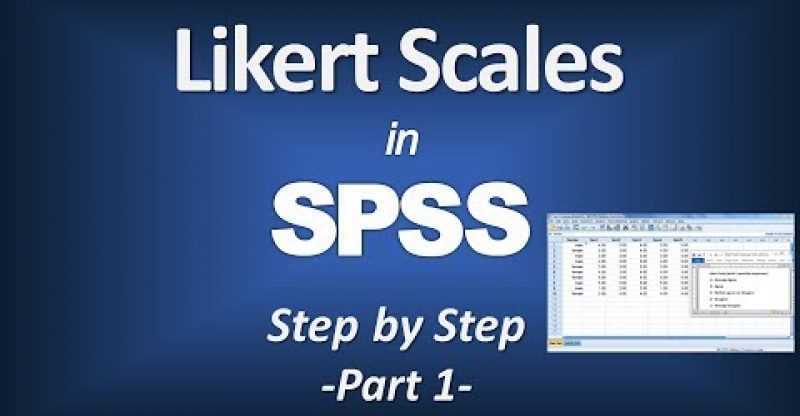Likert Scales and Coding Groups (Copying Value Labels) – Part 1
Learn about Likert Scales in SPSS and how to copy labels from one variable to another in this video. Entering codes for Likert Scales into SPSS is also covered.
Check out our next text, ‘SPSS Cheat Sheet,’ here: http://goo.gl/b8sRHa. Prime and ‘Unlimited’ members, get our text for free! (Only $4.99 otherwise, but will likely increase soon.)
Lots more Likert & SPSS Videos here: https://www.udemy.com/survey-data/?couponCode=SurveyLikertVideosYT
Likert scale SPSS video.
YouTube Channel: https://www.youtube.com/user/statisticsinstructor
Channel Description: For step by step help with statistics and SPSS. Both descriptive and inferential statistics covered. Subscribe today!
Video Transcript: In this video we’ll take a look at how to enter value labels for a variable which will be review since we’ve done that before. But then I also want to show you how to apply value labels that were entered for one variable to a number of different variables which can be really useful as it’s a great time saver. Here in this data set notice that I have 10 people and I have the variables gender, item 1, 2, 3, 4, and 5. And they answered on what’s known as a Likert scale. Now you very well may have heard of a Likert scale before and the first thing is you may have heard of it called LIKE-ERT scale which is very common to call it that but it’s actually Likert, so it’s pronounced LICK-ERT instead of LIKE-ERT and it was developed by Rensis Likert in the early to middle 1900s he developed the scale. And it’s used so commonly, it’s used in this 5-point option as you see here, 5 to 1, and we’ll talk about that in just a moment. You’ll also see it in a 7-point option, it’s very commonly used that way. And less commonly so but you’ll see it in other ways like 9-point scale and so forth. And it’s used with many different kinds of descriptions like definitely true, somewhat true, and so forth; not just agree as you see here. So, in the most traditional use of this scale, which is what we see right here, we have a 5=strongly agree, a 4=agree, 3 is neither agree nor disagree – this is sometimes called neutral – 2 is disagree and then 1 is strongly disagree. On item 1 they would read the following statement: I can turn to others for support when needed. And then what they do is they read that item, they look at these 5 options, and if it’s someone who has a lot of support in their network or friendships or what have you, they might answer 5, strongly agree, or 4, agree. And if it’s someone who doesn’t experience a lot of social support, they might answer a 1 for strongly disagree or a 2 for disagree and so on. So, the first person here in row 1, notice for item 1 they answered a 4, so they answered agree. Item 2 they answered a 5 for strongly agree and so on. If we look down item 1, did anyone answer strongly disagree – let’s take a look at that. We’re looking for a 1 here, and notice that participant number 9, they answered a 1 on item 1, so they answered strongly disagree, and so on. So what I want to do here is go ahead and enter the value labels for item 1 so we’re going to enter these into SPSS that you see here. And then I want to show you how to apply those to the remaining items in a very quick way. First of all, notice that we have gender, if I click on my value labels button here as a review, gender is already coded, I already entered those. But what I don’t have entered is item 1, item 2, 3, 4, and 5. And I’d like to go ahead and enter those to have them in the dataset, so if I go back and look at this file at a later time, I’ll remember that a 5 corresponded to strongly agree and a 1 corresponded to strongly disagree, so in other words I’ll know which direction this scale is scored, and what I mean by that is higher scores indicate greater social support because people strongly agreed with a given item. Whereas lower scores indicated less social support. Since we’re looking at entering value labels, let’s begin with item 1. So I could either double-click on item 1 or I could go to the variable view tab. Let’s go ahead and double-click on item 1 right at the column heading here that’s “name”. So I double-click on that and notice it takes me to the variable view window. So that’s a quick way to get there if you want to access the variable view window. And then we’ll go to the “values” column here, click on the “None” cell and then notice the 3 dots appear. So I click on that and then here let’s start with
Lifetime access to SPSS videos: http://tinyurl.com/m2532td
Video on adding Likert items together to create a total score: http://youtu.be/7jxpSLZCBsw
Likert Scales
Likert
Strongly Agree to Strongly Disagree
Likert in SPSS
source






